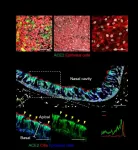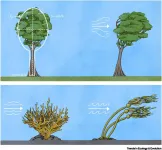Plastic drapes reduce hypothermia in premature babies
Study: Plastic better than cloth for low birth-weight newborns
2021-07-01
(Press-News.org) Most babies born prematurely or with health problems are quickly whisked away to the Neonatal Intensive Care Unit (NICU) where they might require assisted heating devices to regulate their temperature. A University of Houston College of Nursing researcher is reporting that the traditional use of cloth blankets and towels during peripherally inserted central catheter (PICC) placement may hinder heat transfer from the assisted heating mechanisms, increasing the risk for neonatal hypothermia. In Advances in Neonatal Care, Huong (Kelle) Phan, clinical assistant professor, reports that a plastic drape lowers the incidence of hypothermia.
"The use of the plastic drape is a quality improvement to reduce the hypothermia rate in very low birth-weight (VLBW) neonates by replacing cloth blanket/towels with a plastic drape during PICC placement," said Phan. "A plastic drape shows promise in improving nursing practice by providing improved thermoregulation for premature neonates during PICC placement."
When a premature baby's body temperature drops below 36.5°C, the baby may experience cold stress, which is a cause for concern. The recommended temperature range for postnatal stabilization is between 36.5° and 37.5°C.
Phan's research project included implementing plastic drapes over three months, during 58 PICC procedures in a Level-3 NICU. A pre-/posttest was used to evaluate the impact of the intervention on hypothermia rates compared with a baseline cloth group and a concurrent cloth cohort.
"After the 3-month implementation period, the hypothermia rate for the intervention group was lower than that for the baseline cloth group (5.2% and 11.3%, respectively). Post-PICC hypothermia rates were significantly lower for the intervention group than for the concurrent cloth cohort," said Phan.
This evidence demonstrated plastic drapes reduced the hypothermia rate in the NICU for VLBW neonates during PICC placement compared with cloth blankets or towels.
"Phan's innovative nursing intervention of using the plastic drape during a PICC insertion helps some of our most vulnerable patients, those infants that must be treated in neonatal intensive care units," said Kathryn Tart, founding dean and Humana Endowed Dean's Chair in Nursing, UH College of Nursing.
Phan recommends further research to replicate findings with larger samples of PICC insertions, using a plastic drape in the operating room and other NICU procedures.
INFORMATION:
[Attachments] See images for this press release:

ELSE PRESS RELEASES FROM THIS DATE:
2021-07-01
WILMINGTON, Del. (June 29, 2021) - A new report finds that 509,025 (9.17%) public high school students in 24 states experienced homelessness in spring 2019 -- three times the number recognized by the states' education agencies. This under-recognition creates gaps in funding and services needed by this vulnerable population.
Researchers from Nemours Children's Health and the University of Pennsylvania analyzed data from the Centers for Disease Control and Prevention (CDC) for public schools across 24 states and 12 school districts. During spring 2019, more than 9% of public high school students experienced homelessness during a 30-day period in the 24 states. The rate was even higher in the 12 school ...
2021-07-01
New research published today in the journal Blood Advances finds that certain factors, such as a history of severe pain episodes and coexisting organ conditions, increase the risk of severe COVID-19 illness, including hospitalization, in individuals living with sickle cell disease (SCD). According to researchers, the study results underscore the need for COVID-19 risk reduction strategies and vaccination for this medically vulnerable population.
SCD is the most common inherited red blood cell disorder in the United States, affecting an estimated 100,000 people. According to the Centers for Disease Control and Prevention, SCD affects one out of ...
2021-07-01
Understanding how viral infection occurs can provide important clues for researchers to develop strategies to prevent viral transmission and develop effective therapeutic agents and vaccines. SARS-CoV-2, the causative agent of COVID-19, enters the host cells through interaction between the virus's spike protein and the extracellular receptor binding domain of ACE2. The viral entry into the cells is completed by various proteases, which allow the viral and cell membranes to fuse together. While it is known that the upper respiratory tract becomes compromised in the early infection, the exact types of the cells that the virus infects at the earliest stage have not yet been identified.
Led by Director ...
2021-07-01
New research from the Institute of Psychiatry, Psychology & Neuroscience (IoPPN) at King's College London, in collaboration with the University of Liverpool and the Karolinska Institute, has shown that many of the symptoms in fibromyalgia syndrome (FMS) are caused by antibodies that increase the activity of pain-sensing nerves throughout the body.
The results show that fibromyalgia is a disease of the immune system, rather than the currently held view that it originates in the brain.
The study, published today in the Journal of Clinical Investigation, demonstrates that the increased ...
2021-07-01
Extreme differences in flight altitude between day and night may have been an undetected pattern amongst migratory birds - until now. The observation was made by researchers at Lund University in Sweden in a study of great snipes, where they also measured a new altitude record for migratory birds, irrespective of the species, reaching 8 700 metres.
Great snipes are shorebirds that breed in Sweden, among other places, and spend the winter in areas near the equator in Africa. Previous studies have shown that great snipes make long marathon flights of up to 6 000 kilometres lasting 60-90 hours when they migrate between breeding sites in Sweden and wintering ...
2021-07-01
Chatbots have already become a part of our everyday lives with their quick and intuitive way to complete tasks like scheduling and finding information using natural language conversations. Researchers at Aalto University have now harnessed the power of chatbots to help designers and developers develop new apps and allow end users to find information on the apps on their devices.
The chatbot -- 'Hey GUI' (pronounced goo-ee), short for Graphical User Interface, which will be presented at ACM Designing Interactive Systems 2021 on 1 July -- can answer questions by showing images and screenshots of apps, or through simple text phrases.
"Hey GUI eliminates the need for coding skills or technical ...
2021-07-01
Hundreds of different bacterial species live in and on leaves and roots of plants. A research team led by Julia Vorholt from the Institute of Microbiology at ETH Zurich, together with colleagues in Germany, first inventoried and categorised these bacteria six years ago. Back then, they isolated 224 strains from the various bacterial groups that live on the leaves of thale cress (Arabidopsis thaliana). These can be assembled into simplified, or "synthetic" plant microbiomes. The researchers thus laid the foundations for their two new studies, which were just published in the journals Nature Plants and Nature Microbiology.
Volume control of the plant response
In the first study, the researchers investigated ...
2021-07-01
A team of scientists has devised a more accurate way to predict the effects of climate change on plants and animals -- and whether some will survive at all.
Frequently, ecologists assess an organism's fitness relative to the climate by quantifying its functional traits.
"These are physical properties you can measure -- height, diameter, the thickness of a tree," said UC Riverside biologist Tim Higham. "We believe more information is needed to understand how living things will respond to a changing world."
The team, led by Higham, outlines an alternative model for researchers in an article ...
2021-07-01
NEW YORK, NY (July 1, 2021)--Lowering levels of a hormone called PTHrP can prevent metastases and improve survival in mice with pancreatic cancer and could lead to a new way to treat patients, according to a study from cancer researchers at Columbia University Vagelos College of Physicians and Surgeons and Herbert Irving Comprehensive Cancer Center and with collaborators at the University of Pennsylvania.
When patients are first diagnosed with pancreatic cancer, the cancer usually has spread to other organs. Because of these metastases, nearly all patients will succumb to their cancer within one year of diagnosis, but no drugs exist to prevent metastasis.
In an effort to find treatments, cancer researchers at Columbia--led by ...
2021-07-01
What if a microscope allowed us to explore the 3D microcosm of blood vessels, nerves, and cancer cells instantaneously in virtual reality? What if it could provide views from multiple directions in real time without physically moving the specimen and worked up to 100 times faster than current technology?
UT Southwestern scientists collaborated with colleagues in England and Australia to build and test a novel optical device that converts commonly used microscopes into multiangle projection imaging systems. The invention, described in an article in today's Nature Methods, could open new avenues ...
LAST 30 PRESS RELEASES:
[Press-News.org] Plastic drapes reduce hypothermia in premature babies
Study: Plastic better than cloth for low birth-weight newborns





